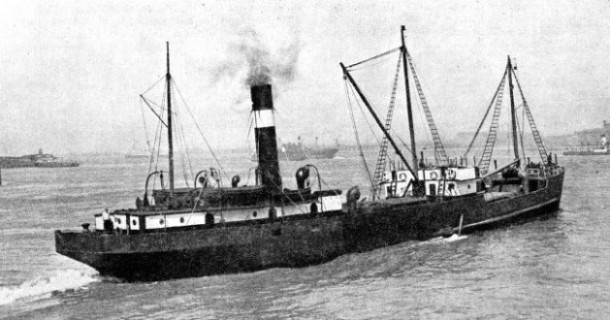

© Shipping Wonders of the World 2012-

Britain’s Coastal Trade
The geographical position of the British Isles and their proximity to the mainland of Europe have given rise to an important coastwise trade, not only within British waters but also to neighbouring European coasts. The coastal trade of Great Britain has been described as the Cinderella of the transport industry
REGISTERED AT WEXFORD, IRELAND, the Wexfordian, a three-
THE coastal trade of Great Britain has been described as the Cinderella of the transport industry — not that the other branches are necessarily the ugly sisters. It is certainly true that in conjunction with sea services generally the coastal trade has been somewhat neglected and forgotten.
As an alternative system of transport it is by a large margin the most economical to run. There is no restriction as to size and quantity of cargo it can carry and it is indispensable in the defence system of the country. It constitutes a valuable reserve of numerous small and efficient vessels and well-
Many of them were taken up by the Admiralty and converted for a number of purposes, notably for minesweeping and Q-
Coastal trade had its origin when the early Briton paddled his rough-
Although Great Britain is an island, its proximity to the mainland of Europe enables coasting vessels to trade with ports on neighbouring foreign coasts. So, paradoxically perhaps, Britain’s coastal trade includes trade with English Channel and European ports. Coastwise trade had spread across the English Channel many centuries B.C. This is known by the discovery of ancient English pottery, jet and other articles over 4,000 years old in France and Spain.
An interesting variety of commodities was being shipped between the ports which the Romans had established at Londinium (London), Rutupiae (Richborough, Kent), Magnus Portus (Portsmouth), and Camulodunum (Colchester), extending later up to Segedunum (Wallsend-
When the Romans withdrew the Britons allowed their shipping to fall into a bad state, and the Anglo-
One of the earliest booms in the coastal trade occurred in the thirteenth century, when large quantities of wool were being exported, principally to Flanders. Another boom began in 1347 after the surrender of Calais to Edward III, when large quantities of French wines were shipped to England. This date is important because these wine shipments were responsible for the method of ship measurement which lasted for many years. The capacity of a vessel was calculated according to the number of “tuns” or casks of wine she could carry.

IN THE RIVER MERSEY the Stock Force, 983 tons gross, passes Liverpool Landing Stage. The Stock Force is registered at Whitehaven, Cumberland, and is owned by the West Coast Shipping Co. Ltd. She has a length of 203 feet, a beam of 33 ft 11 in and a depth of 13 ft 1 in. She was built in 1917 and served as a Q-
It is to coal, however, that British coastal trade owes its principal sustenance and development. When coal was first mined at Newcastle about 1230-
One of the earliest coastwise charters recorded is dated 1290, when a vessel was engaged to deliver a cargo of cedar, wine, wheat and oats from London to Berwick-
Coastal trade considerably increased at that time. Figures available for the year 1728 show that out of 8,886 vessels entering London as many as 6,837 were coastal craft. Seventy years later the number of coastal craft had increased to 11,964, so that the Thames was much crowded and the scene of considerable confusion. It was largely due to this congestion caused by coastal ships that the East and West India Docks were built.
Romantic Names
Coastal shipping consisted of a variety of craft and the names of some of them lend a romantic touch which has almost entirely disappeared to-
In Tudor times vessels had increased in variety and included hoys, cats, bilanders, pinks, keels and cogs, followed by smacks, cutters, sloops and brigs. The brigs came into prominence at the
beginning of the eighteenth century and were an improvement on the schooner rig. They became famous in the north-
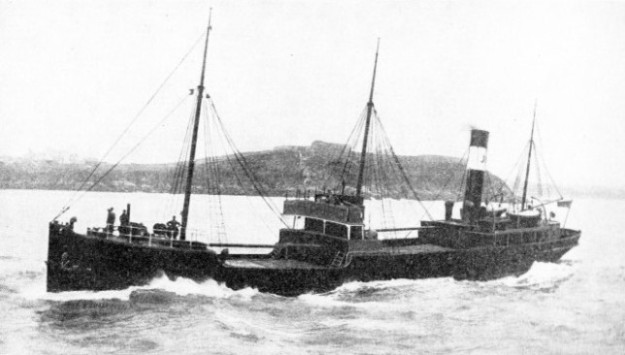
ROUND THE BRITISH COAST ply many craft of the type represented by the Clara Monks. She is a three-
Experiments with steam-
The first cross-
The great Atlantic Ferry services which operate to-
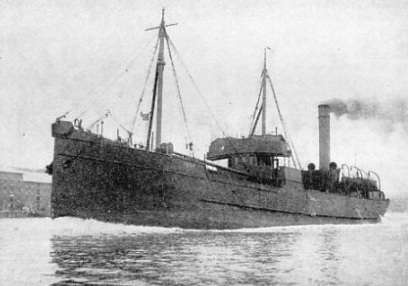
WITH MACHINERY AFT, the Test, a well-
On the East Coast steam had not made its mark so rapidly for cargo services. The great bulk of the coal trade was in the hands of the collier brigs which had proved adequate to handle the cargoes satisfactorily, until the railways began to take a hand in the transportation. In 1842 a small iron collier, the Bedlington, was built for carrying coal on the short journey from Blyth
to the Tyne. She was fitted with a screw propeller, and was the first iron screw collier, the founder of the modern and efficient steam colliers seen to-
Among several interesting experimental vessels which followed were the Q.E.D. and the John Bowes. The Q.E.D. was a sailing vessel to which was added a screw as an auxiliary power, but she was the first vessel to be fitted with a double bottom for water ballast.
Eighty-
The John Bowes has been erroneously credited with being the first iron screw collier, which is probably due to the great publicity that was given to her at her launch from Palmers yard at Newcastle in 1852. She was put into Tyne-
The success which attended these experiments established unquestioned the supremacy of steam, and completely drove the picturesque Geordie brigs off the sea. During the last decade of their existence they were unable to pay their way, and were only able to sail at all through the most drastic economies, so that, with bad gear, rotting timbers and inadequate crews, the losses among them were enormous. In 1865 the appalling number of 675 collier brigs was lost under these conditions. Other experiments included the freak ship Connector, and extended to improved methods of trimming and discharging. Later pioneering experiments successfully applied in coastal vessels include the steam turbine, introduced in the passenger coasters King Edward and Queen Alexandra in 1901 and 1902 on the Clyde. The geared turbine was successfully applied to the steamers Hantonia and Normania in 1911.
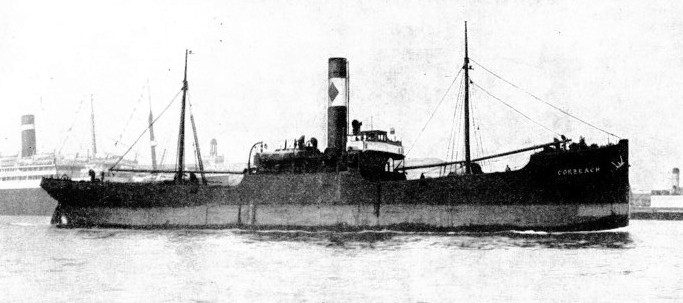
THE BLACK DIAMOND ON THE FUNNEL is characteristic of the colliers owned by Cory Colliers, Ltd. The Corbeach, a vessel of 1,569 tons gross, was built in 1913 as the Valegarth. She has a length of 245 feet between perpendiculars, a beam of 36 ft. 2 in. and a moulded depth of 21 feet. She has been sold to the Angelus Shipping Co., Ltd.
The next step in development was the motor vessel, and here the Thames claims the credit for having built the first motor coaster. The Grit was built at Greenhithe in 1913 by F. T. Everard. She was a small wooden ketch of 147 tons. Then war came in 1914 and while British coastal vessels and their crews, and many of their owners, were engaged on national service, the foreigner took the opportunity of considerably increasing his shipping and trade with our ports, thus establishing a footing whose effects have been felt ever since.
This foreign “invasion” has kept British coastal vessels laid up and their crews unemployed, until it was at length realized that British coastal craft must be built which were capable of competing with these foreign ships. The Dutch developed an efficient class of motor vessel of shallow draught, economical to run, capable of handling most cargoes with their own derrick and cheaply manned. The captain, his wife and family generally formed the complement. As long ago as 1603 Sir Walter Ralegh complained that the Dutch were cutting out the English coastal trade with their low freights, greater carrying capacity and smaller crews, and an Act was passed forbidding the shipment of goods in any but English ships.
Recent years, however, have seen great improvements in British coastal ships being put into service, for they are fully capable of competing with foreign vessels. Everard’s Angularity, which represented British coastal trade at the Jubilee Review in 1935, and the Coast Lines’ Pacific Coast are examples of the efficient modern motor coaster.
The prodigious quantities of coal used in London by the public utility undertakings exercised the skill of the naval architect in evolving a type of vessel which would carry large consignments of coal on a shallow draught and so be independent of tides and negotiate all the river bridges at the flood tide when necessary. Thus a type known as the “flat iron” came into being.
These vessels are so named from their squat appearance when seen on the Thames. Their bridge is low in comparison with that of a normal cargo steamer, and all necessary deck fittings, Such as their funnel, ventilators and boat davits, are hinged so that they are easily laid flat on deck, while the short mast telescopes into a tube leading down into the fore hold. Thus representing some what the domestic flat-
This type and the modern motor coaster have done more to restore British coastal trade supremacy than anything else.
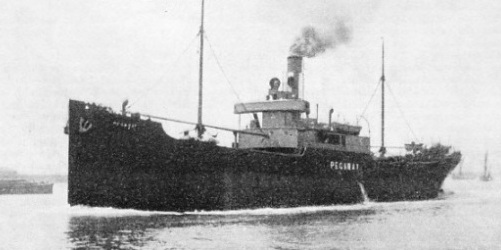
BUILT IN 1924, the Pegaway, 1,826 tons gross, has a length of 260 feet, a beam of 39 ft 2 in and a moulded depth of 21 feet. She is owned by the Hill Steam Shipping Co. Ltd., of Newcastle-
These improvements are encouraging to British coastal trade, so far as the principal coastal shipping lines are concerned, but the small owner and tramp coasters do not benefit and still suffer from the foreign competition, principally owing to their inability to finance new construction. However much shippers may be willing to cooperate by sending their goods in British ships, it is only natural that the best ships get the cargoes. In this direction much might be done to help the British coastal tramp if the banks would assist in financing new and efficient tonnage.
Motor Coasters
Moreover, there is now another system of transport being revived which will have to be taken into consideration, namely, the inland waterways. British canals are now being modernized, and new types of barges are under construction, with a capacity of 72 tons of cargo and installed with diesel engines.
A subsidy has been suggested to tide over the slump period, but this is not desired by the coastal trade, nor is it a remedy in the long run. The remedy lies in co-
It is important to keep in mind the great number of ports around Great Britain which are served by coastal vessels, from the large sea ports to the small, yet none the less important, harbours in between and hidden in the rivers and creeks. Statistics show that there are more navigable ports round the British coastline than in the corresponding distance of any other seaboard. Over three-
Apart from the Thames barges, the few old die-
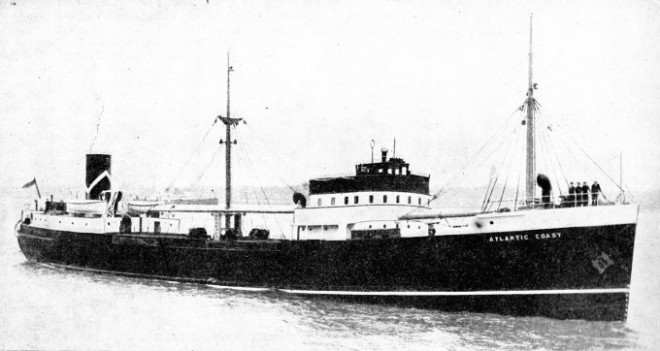
A MODERN DIESEL-
You can read more on “British Shipping”, “Progress of the Motorship” and “Twixt Highlands and Hebrides” on this website.
